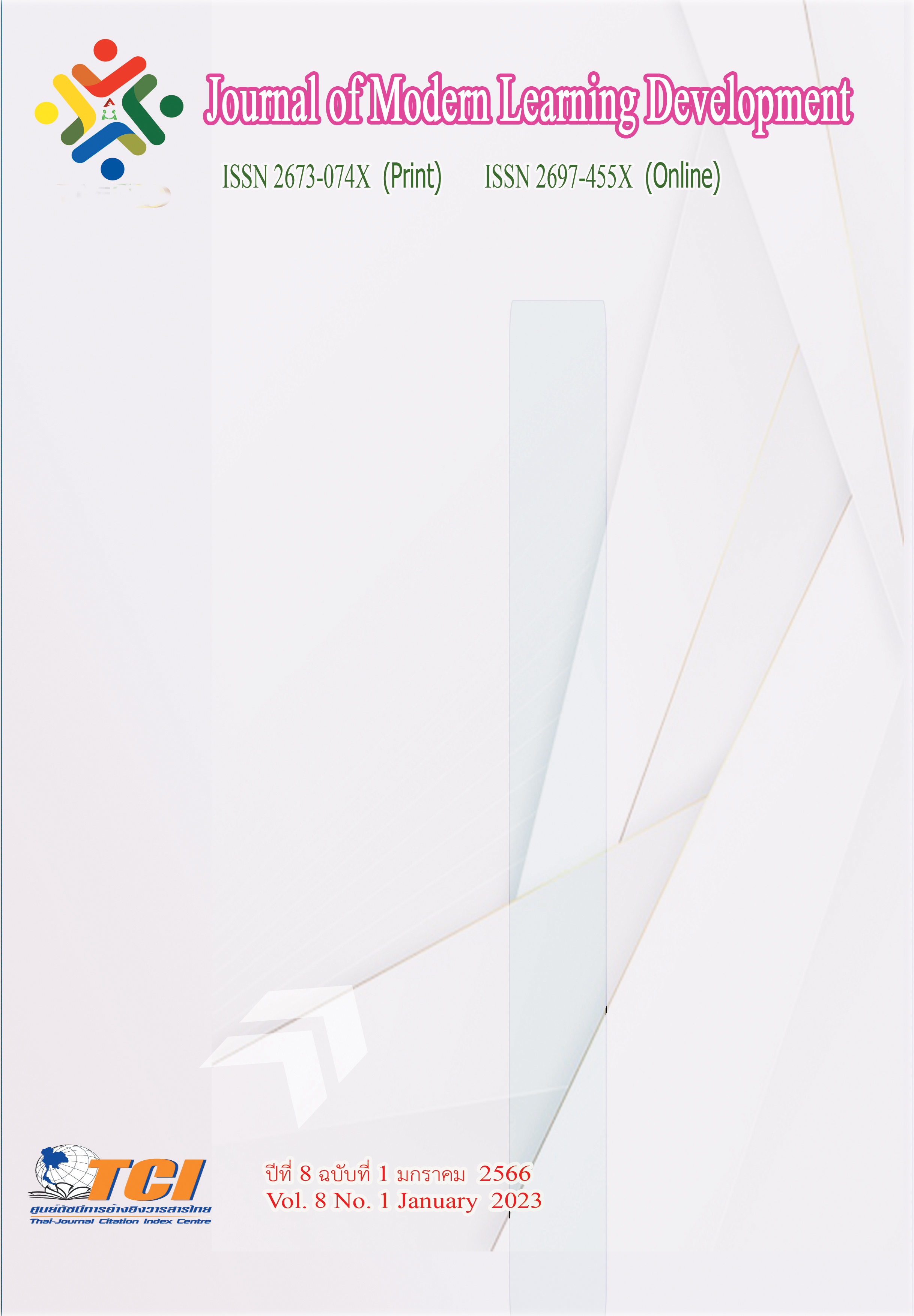Development of Students’ Learning Outcomes with Learning Activities Package on the Categories of Thai Words Using Flipped Classroom Technique for the 3rd Year Chinese Students
Main Article Content
Abstract
The objectives of this research were to: 1) study the process of developing learning outcomes with learning activities package on the categories of Thai words by using flipped classroom technique for a group of 3rd year Chinese students, and 2) compare the learning outcomes from pre-test and post-test with learning activities package on the categories of Thai words by using flipped classroom technique for the 3rd year Chinese students. Pre-Experimental Research Design. There were 2 sets of research tools used in the research, which were divided into 1. learning management tools, that was a learning management plan with flipped classroom technique with learning activities package, and 2. the data collection tool was the categories of Thai words test. The sample group of this research was 68 3rd year students in the Thai language program from Southwest Forestry University in 1st semester, academic year 2021, and it was obtained by Cluster sampling. The statistics used in data analysis were mean, standard deviation, and t-test (dependent t-test). The results of the study revealed that:
1. The process of developing learning outcomes with learning activities package on the categories of Thai words by using flipped classroom technique for the 3rd year Chinese students produced a 7-asynchronous units combination between a traditional study and self-study and 7-synchronous units in the classroom. Students studied the content on the categories of Thai words from learning activities package which was created by the researcher. There were a pre-test and a post-test to evaluate the students’ achievement on the categories of Thai words before and after studying.
2. The comparison of the learning outcomes from learning activities package on the categories of Thai words by using flipped classroom technique found that the average score of the pre-test was 15.68 and the mean score of the post-test was 33.68. In addition, the students' post-test scores were significantly higher than the pre-test scores at a level of .05.
Article Details
References
จตุภูมิ เขตจัตุรัส. (2562). การวิจัยชั้นเรียน: กระบวนการสร้างความรู้เพื่อใช้พัฒนาการเรียน การสอน. โรงพิมพ์มหาวิทยาลัยขอนแก่น.
นิภา กู้พงษ์ศักดิ์. (2560). ผลสัมฤทธิ์ทางการเรียนวิชาภาษาไทยเพื่อการสร้างสรรค์และความพึงพอใจต่อวิธีการสอนแบบห้องเรียนกลับด้าน.วารสารบัณฑิตศึกษา มหาวิทยาลัยราชภัฏวไลยอลงกรณ์ ในพระบรมราชูปถัมภ์. 11 (1), 133-146.
ปิยมาศ บุดดาน้อยและคณะ. (2563). การพัฒนากิจกรรมการเรียนรู้ตามทฤษฎีการสร้างความรู้ด้วยตัวเองร่วมกับกลวิธี STAR ที่ส่งเสริมความสามารถในการแก้โจทย์ปัญหาและผลสัมฤทธิ์ทางการเรียนวิชาเคมี เรื่องปริมาณสารสัมพันธ์ ของนักเรียนชั้นมัธยมศึกษาปีที่ 4. วิทยานิพนธ์ปริญญาโท. บัณฑิตวิทยาลัย: มหาวิทยาลัยมหาสารคาม.
ปิยะวดี พงษ์สวัสดิ์ และณมน จีรังสุวรรณ. (2558). การ ออกแบบรูปแบบการเรียนการสอนแบบห้องเรียนกลับด้านโดยใช้กิจกรรม WebQuest เพื่อพัฒนาทักษะการเรียนรู้ในศตวรรษที่ 21 สำหรับนักศึกษาในระดับอุดมศึกษา. วารสารวิชาการครุศาสตร์ อุตสาหกรรม พระจอมเกล้าพระนครเหนือ. 6 (1), 151-58.
พิชญ์สินี ไสยสิทธิ์. (2561). การพัฒนารูปแบบห้องเรียนกลับด้านบนคลาวด์โดยใช้การเรียน แบบปัญหาเป็นฐานในสังคมพหุวัฒนธรรมเพื่อส่งเสริมการคิดอย่างมีวิจารณญาณ. วิทยานิพนธ์ปริญญาโท, บัณฑิตวิทยาลัย: จุฬาลงกรณ์มหาวิทยาลัย.
วิจารณ์ พานิช. (2556). ครูเพื่อศิษย์สร้างห้องเรียนกลับด้าน. เอสอาร์พริ้นติ้งแมสโปรดักส์.
วิรัช วงศ์ภินันท์วัฒนา. (2557). การใช้ภาษาไทยในกระบวนการสื่อสารข้ามวัฒนธรรมของนักศึกษาต่างชาติ สาขาวิชาภาษาไทย [วิทยานิพนธ์ปริญญาโท. บัณฑิตวิทยาลัย: มหาวิทยาลัยขอนแก่น.
ศรินยา วงษ์ช่างหล่อ และคณะ.. (2560). ผลการจัดกิจกรรมการเรียนรู้แบบห้องเรียนกลับด้านที่มีต่อผลสัมฤทธิ์ทางการเรียนและความรับผิดชอบ ในการเรียนหลักการใช้ภาษาไทยของนักเรียน ระดับชั้นมัธยมศึกษาตอนปลาย โรงเรียนสวนศรีวิทยา จังหวัดชุมพร [เอกสารนำเสนอ]. การประชุมเสนอผลงานวิจัยระดับชาติ มหาวิทยาลัยสุโขทัยธรรมาธิราช ครั้งที่ 8, กรุงเทพมหานคร.
สุทธิยา สุวรรณและคณะ. (2555). ผลการจัดการเรียนรู้ตามแนวคิดคอนสตรัคติวิสต์ของไดรเวอร์และเบลล์เสริมด้วยผังมโนทัศน์ ต่อผลสัมฤทธิ์ทางการเรียนวิชาวิทยาศาสตร์และความสามารถในการคิดวิเคราะห์ ของนักเรียนชั้นประถมศึกษาปี ที่ 5 [วิทยานิพนธ์ปริญญาโท. บัณฑิตวิทยาลัย:มหาวิทยาลัยราชภัฎอุดรธานี.
อมรรัตน์ รัชตะทวีกุล. (2561). ผลการจัดการเรียนรู้โดยใช้รูปแบบห้องเรียนกลับทางที่มีต่อผลสัมฤทธิ์ทางการเรียนและเจตคติต่อ การเรียนวรรณคดีไทยของนักเรียนชั้นมัธยมศึกษาปีที่ 6. วิทยานิพนธ์ปริญญาโท. บัณฑิตวิทยาลัย: มหาวิทยาลัย ศรีนครินทรวิโรฒ.
Driver, R. and Bell, B. (1986). Students’ thinking and the learning of science: Aconstructivist view.The School Science Review. 67 (240), 443-456.


